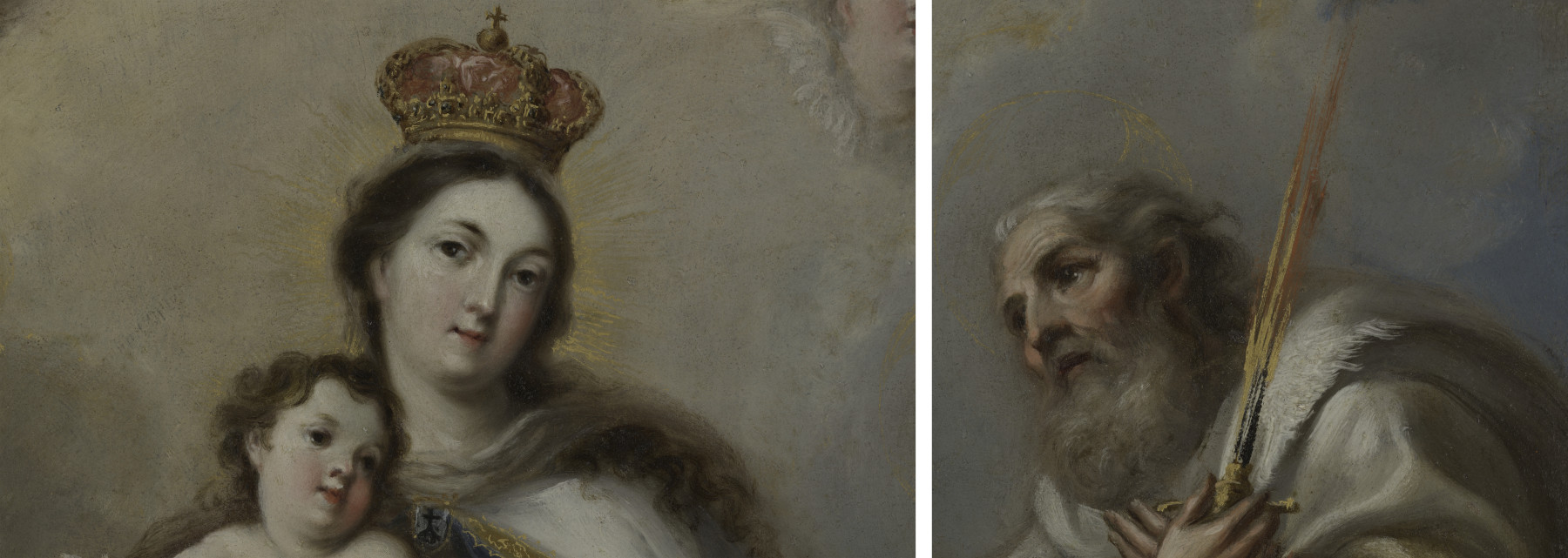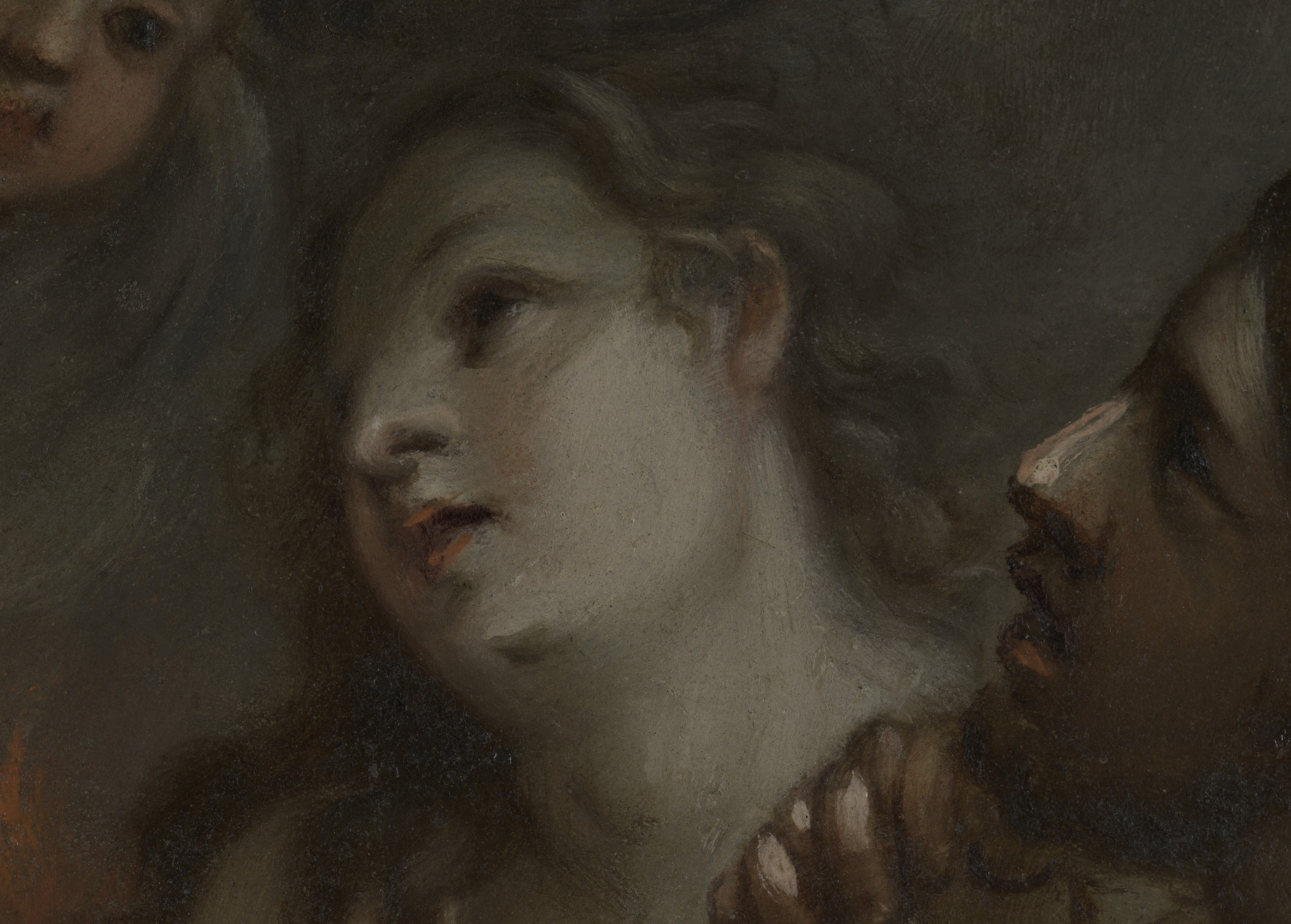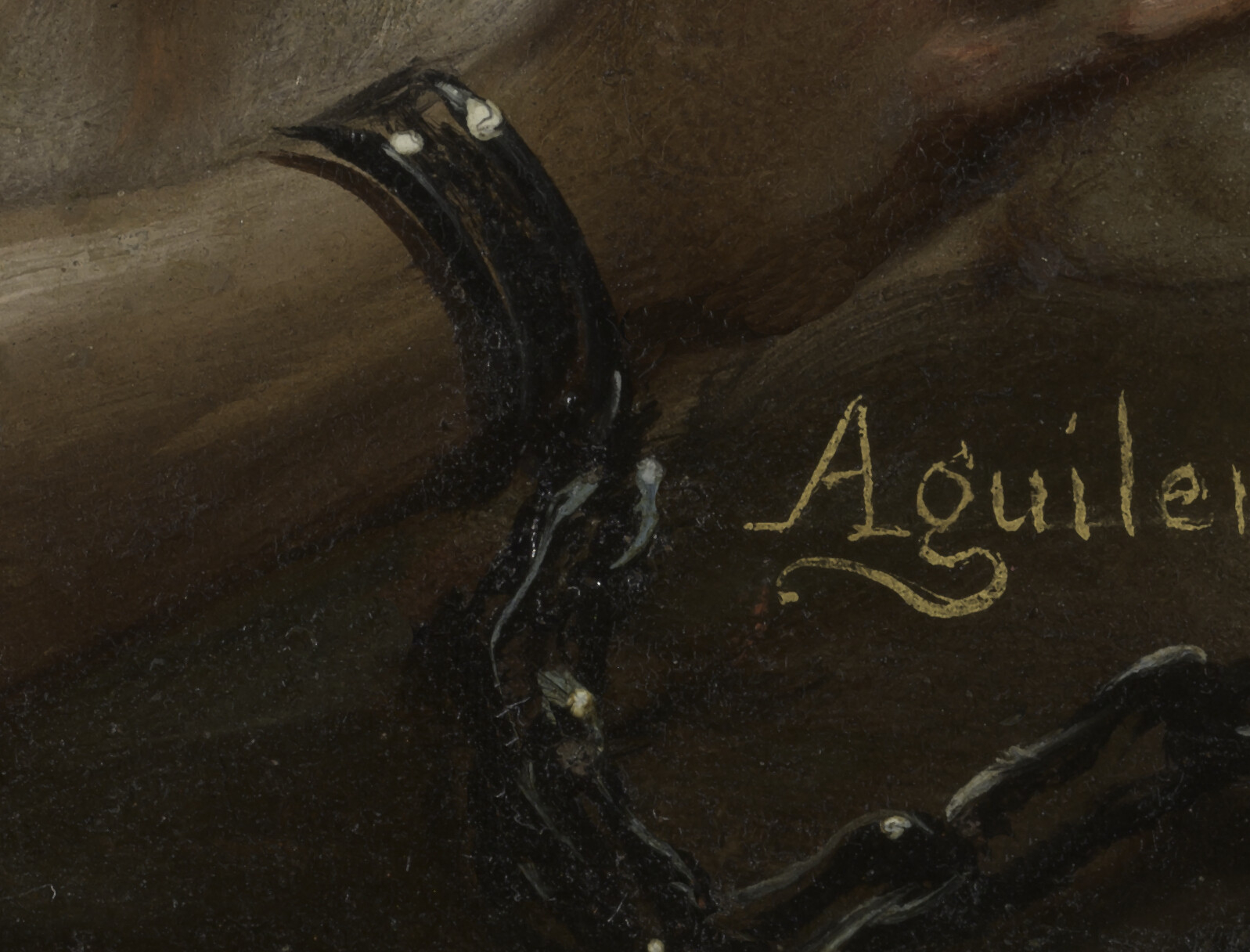Bold Gestures in a Devotional New Spanish Painting on Copper by Juan Francisco de Aguilera
José L. Lazarte, Silvia A. Centeno and Federico Carò
Introduction
In 2017 The Metropolitan Museum of Art acquired The Virgin of Carmen and the Souls of Purgatory with Saint Joseph and the Prophet Elijah (ca. 1720; inv. 2017.234) by Juan Francisco de Aguilera (act. New Spain, Mexico, first third of eighteenth century). The conservation treatment of this painting (Fig. 1) presented the opportunity for a technical examination, allowing insight into the materials and techniques employed by the artist. This study, one of the first dedicated to a work by Aguilera, involved surface examination under the microscope, infrared reflectography (IRR), point X-ray fluorescence (XRF), Raman spectroscopy, macro X-ray fluorescence (MA-XRF) mapping, and the examination and analysis of selected cross-section samples by optical microscopy and Raman spectroscopy. The accompanying period frame was also analyzed as it is thought to be original to the painting and could provide information about the initial owner and framing tastes for New Spanish paintings destined for private devotion.
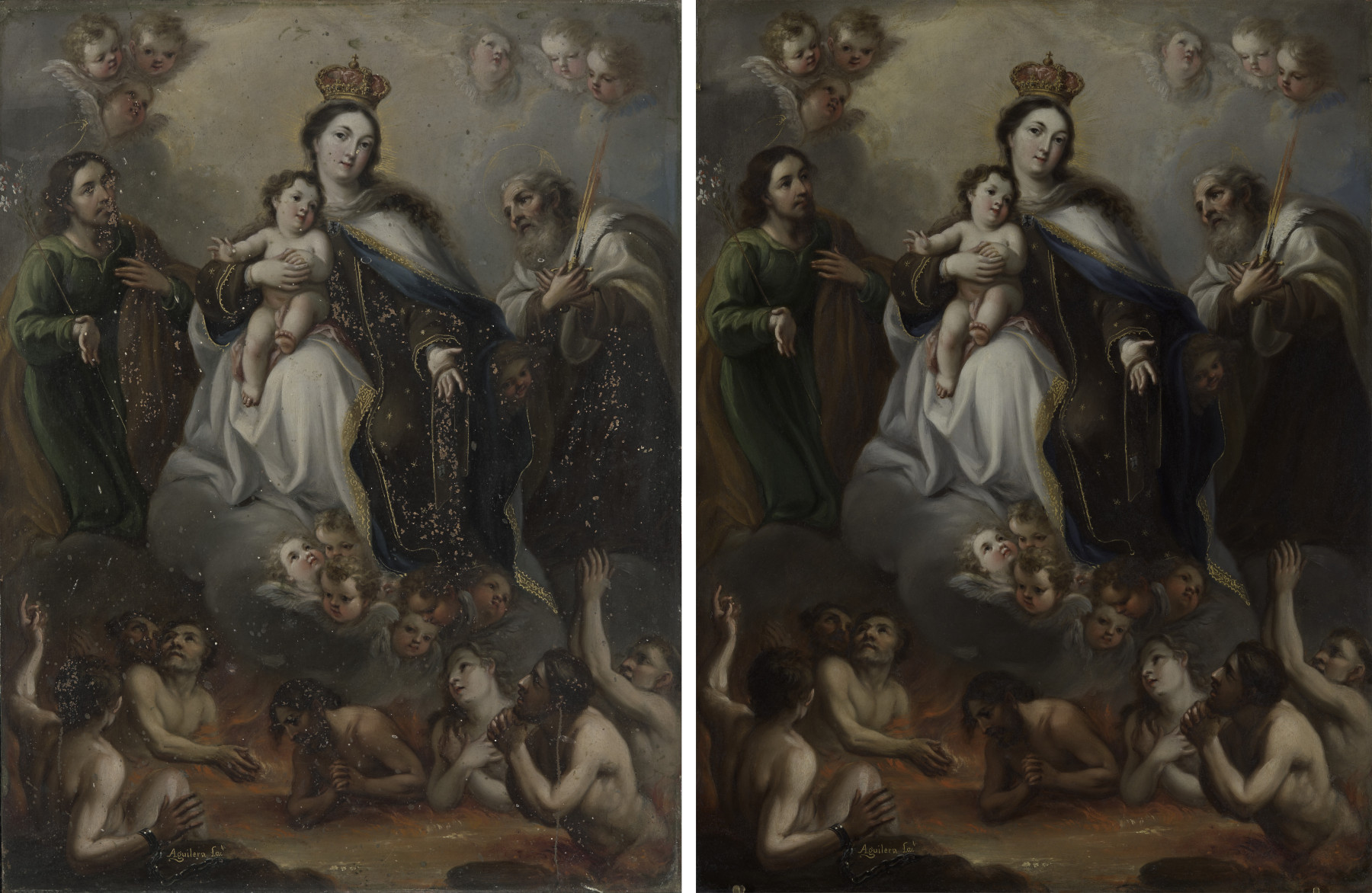 Fig. 1
Fig. 1The Virgin of Carmen is an important addition to The Metropolitan’s growing collection of New Spanish paintings on copper, which includes a work by the influential painter Juan Rodríguez Juárez (1675–1728). Rodríguez Juárez, along with his older brother Nicolás (1666–1734), organized an exclusive art academy in Mexico City, of which Aguilera was a member.1 In 1722 eleven New Spanish artists signed a document granting the painter José de Ibarra (1688–1756) the authority to represent their academy in the creation of an ephemeral triumphal arch for the entry of viceroy Juan de Acuña y Bejarano, who ruled New Spain from 1722 to 1734.2 Research into the function of this academy and its influence on painting styles in eighteenth-century Mexico remains the subject of speculation. However, it is clear that painters were seeking social, professional, and political recognition.3 This academy may have been formed partly in response to the relative absence of artists’ organizations after the decline of the Guild of Painters of Mexico City between 1707 and 1717.4
No secure biographical records are known for Aguilera, other than the confirmation of his presence in Mexico City during the second decade of the eighteenth century as an accomplished artist. Because of his sudden appearance in Mexico at the Juárez brothers’ academy and his stylistic resemblance to Murillo, it has been suggested that he was a foreigner, probably from Spain.5 This has made his possible birth in Mexico a subject of debate.6 Recently, however, two baptismal certificates from Mexico City, issued in 1671 and 1680 respectively, have surfaced for individuals with the same name.7 In any case, Aguilera’s close connection with the most renowned New Spanish painters of his time, through the Juárez academy, would have had an influence on his technique and that of his colleagues.
An exceptional text positions Aguilera as an important figure among his peers, demonstrating his recognition in New Spain. The Spanish translation of the treatise, Prodromo, overo saggi di alcune invenzioni nuove premesso all’Arte Maestra, published in 1670 in Brescia, Lombardy, by the Jesuit priest Francesco Lana Terzi (1631–1687), is one of the few translations about artistic practice known from eighteenth-century New Spain. Possibly dating to the 1740s,8 the translation includes an unprecedented statement in which Aguilera’s direct method of paint application is said to have been novel in Mexico:
Some make on their palettes various paint mixtures arranged by the use that they will assign to them: in our Kingdom of the Indies, this unpleasant ineptitude lasted many years; until Juan Rodríguez Juárez, el Villalpando, and Aguilera, very famous for their paintings, rejected with truly heroic spirits this tiresome diffidence, introducing the mixture of colors with brushes onto the canvas.9
In this statement, Aguilera’s association with influential, prolific artists such as Cristóbal de Villalpando (1649–1714) and Juan Rodríguez Juárez (1675–1728) is somewhat unexpected, given the dearth of information on Aguilera and the few known paintings ascribed to him.10 The comment reveals that his painterly technique was considered innovative by his contemporaries, a statement that holds true today. Scholars have proposed that Aguilera’s soft and vaporous painting effects anticipated those that were common to New Spanish painting throughout the eighteenth century.11 The statement alluding to Aguilera’s paint manipulation on the canvas has been interpreted to describe not only a direct application, but also the optical effects that could be achieved by the layering of semi-translucent paint over colored grounds.12 His few extant works reveal that he was a versatile artist, capable of rendering complex compositions, both small and large, on a variety of supports, including canvas and copper. Aguilera’s choice of different supports and formats did not affect his painterly style; he was able to re-create bold brushstrokes not only on a large scale but also in miniature. The artist’s adaptability is underscored in two paintings depicting the Immaculate Conception, the first being a large canvas signed in 1720, measuring 420.5 cm in width, and the second a wearable nun’s badge on copper, dated to 1720–30 and only measuring 17.5 cm in diameter (Figs. 2, 3). Aguilera’s characteristic paint handling is most evident in the figures of both compositions, demonstrating his consistency as a technician.
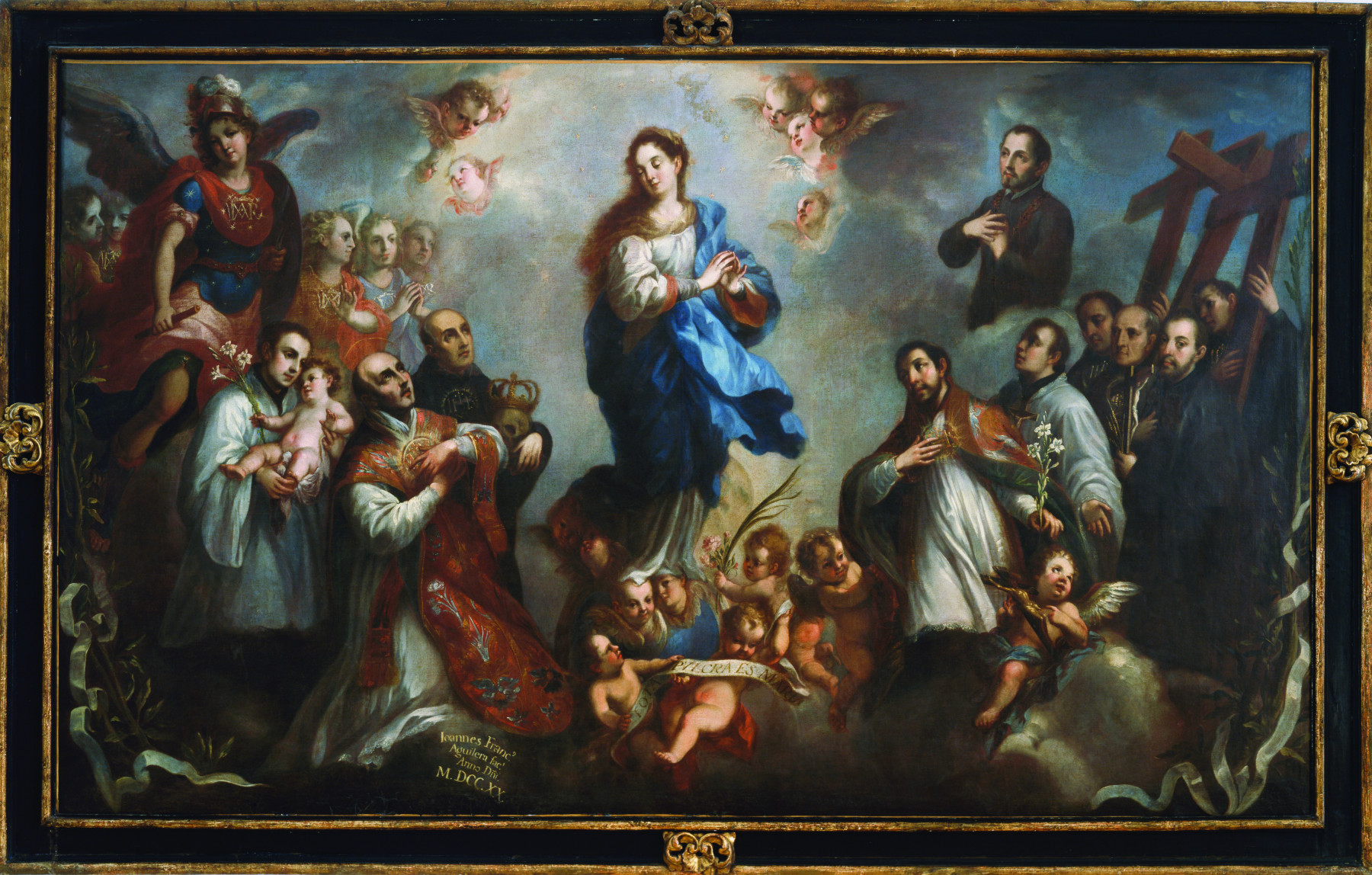 Fig. 2
Fig. 2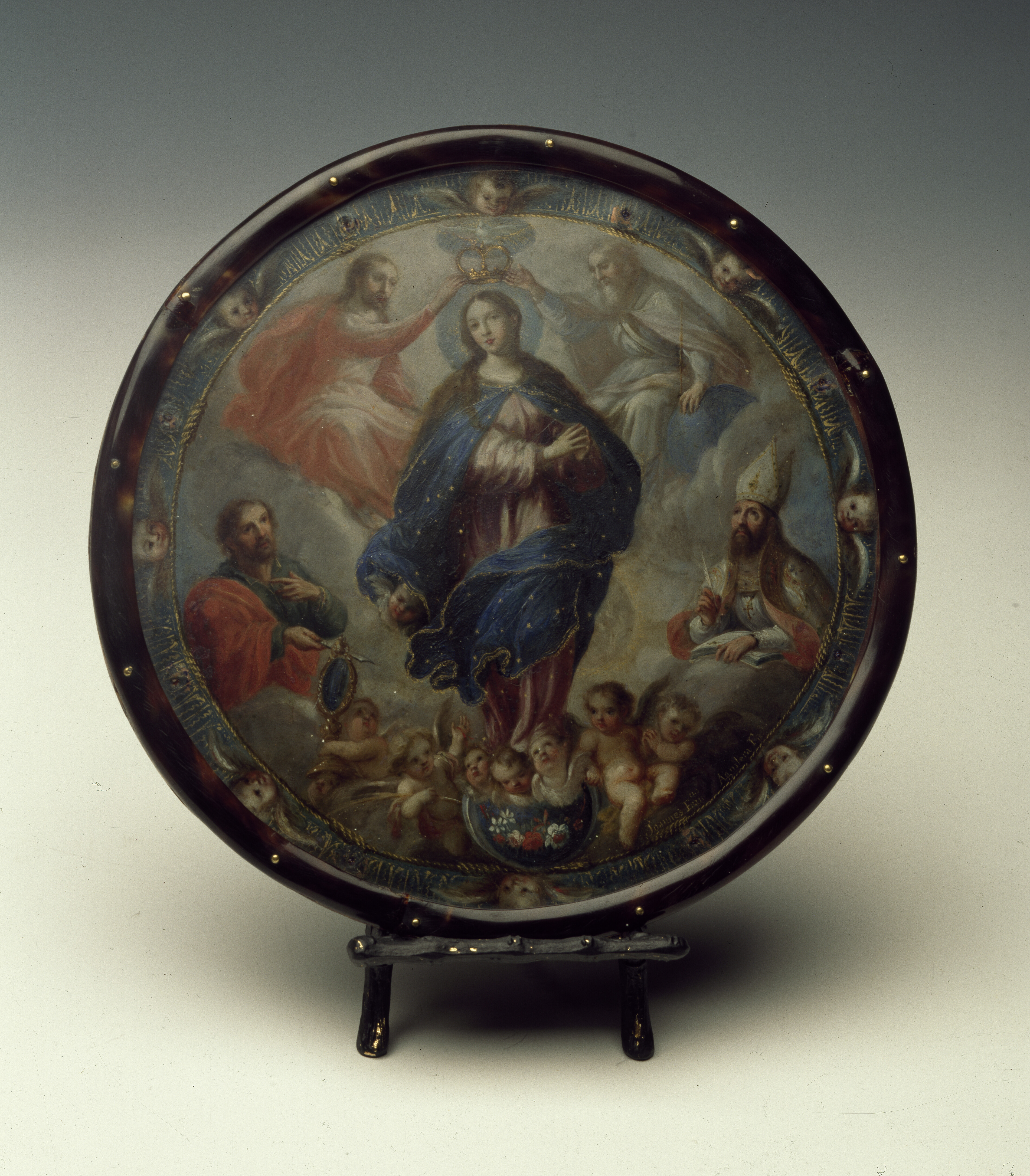 Fig. 3
Fig. 3Very little is known about The Virgin of Carmen, which was held in a private collection in Jerez de la Frontera, near Cadiz, Spain, since the mid-nineteenth century. In this work, Aguilera painted the Virgin*,* flanked by Saint Joseph and the Prophet Elijah, levitating over souls in purgatory. In Roman Catholicism, purgatory is the realm after death in which souls, materialized with their former nude bodies in this composition, are purified through punishment before reaching eternal life.13 As the souls in Aguilera’s painting pray for forgiveness, the Virgin lowers her Carmelite scapular, which provides a passage to heaven. Possibly considering his own mortality, Aguilera placed his signature above, almost encircled by the iron shackles restraining one of the souls (Fig. 10). The iconography suggests that the painting was commissioned by a member of one of the several Carmelite confraternities in Mexico. The Virgin of Carmen gained many followers in New Spain due to her role interceding in spiritual salvation, appeasing the anxiety provoked by death.14 Indeed, the reduced format of the copper support and the intricacy of its execution suggest that the image was used for spiritual atonement through private prayer.
The Copper Support
Aguilera likely acquired the metal support readymade from a coppersmith, having negotiated the dimensions of the commission with his patron. The support15 is largely composed of copper with small amounts of lead, which is consistent with the elemental makeup of an unalloyed copper sheet.16 The dark reddish color of the reverse is due to the presence of red cuprous oxide (Cu~2~O), which may form when the metal interacts with humidity in the environment.17
While little is known about the supply of copper supports for painting in Mexico during this period, the large number of paintings on copper in the region suggests that business was profitable and steady. In fact, more paintings on copper were created in New Spain than in any other Spanish territory, even the Iberian Peninsula itself.18 The predilection for this metal support in Mexico has been explained by the presence of prosperous pre-Hispanic copper mines active in the region of Michoacán during the viceregal period (1521–1821).19 Moreover, New Spanish artists were taken by the lustrous effects they could achieve on the metallic surface, embodied particularly in Flemish, but also Italian, paintings on copper imported to New Spain throughout the seventeenth century.20
On the copper support used for The Virgin of Carmen, several shallow round dents, visible when examined in reflected light on the reverse, correspond to the marks left by the hammer used to planish the sheet over a hard, flat surface (Fig. 4a). Being malleable and ductile, a copper ingot could easily be worked into a sheet with a planishing hammer.21 After annealing in an open fire, hammering not only imparted the desired even surface but also rendered the sheet less flexible, while assuring a thin profile.22 These characteristics were ideal for the creation of lightweight portable images such as this devotional painting.
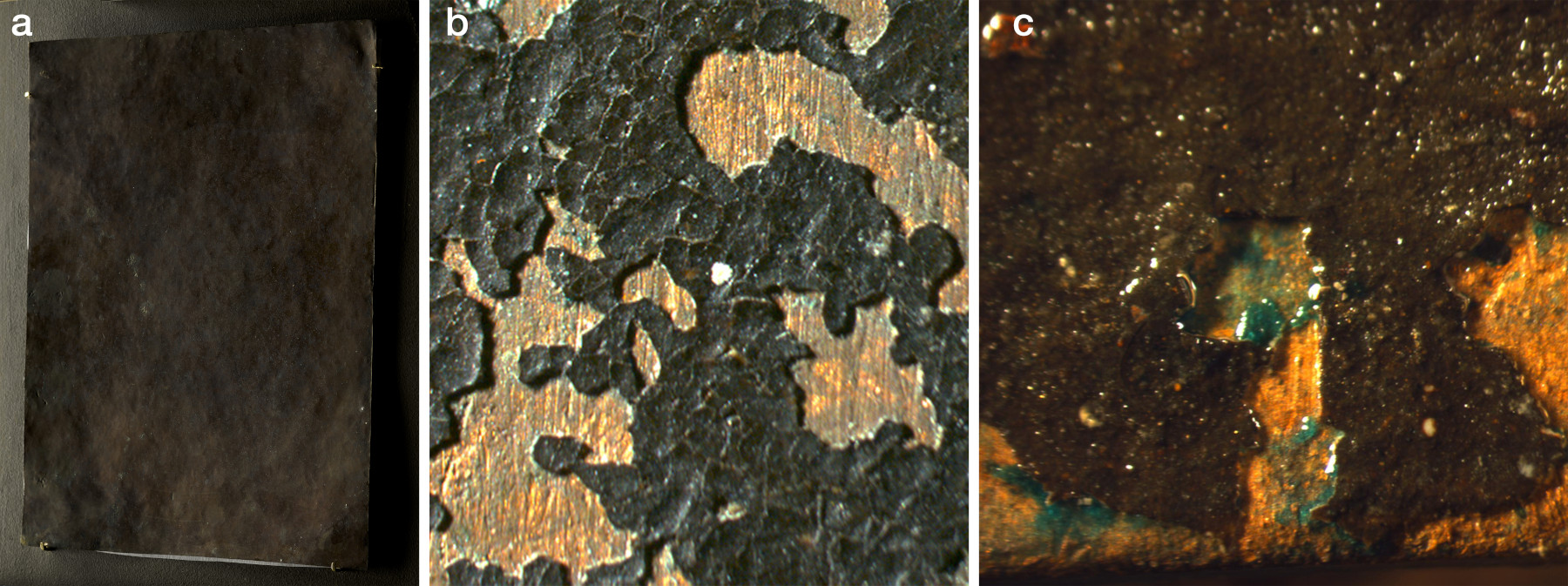 Fig. 4
Fig. 4Preparation
To date there are no known New Spanish art treatises or documents that discuss the preparation of copper supports. European art treatises, especially Spanish ones available to New Spanish artists,23 are nonetheless useful sources for elucidating the priming methods seen in Aguilera’s painting. This being said, European art treatises alone cannot be regarded as primary sources for New Spanish techniques. Indeed, it has been shown that canvas preparation methods used by artists in New Spain throughout the seventeenth and eighteenth centuries differed from those described in Spanish treatises.24 In addition, the transmission of knowledge mostly occurred in tacit form and thus varied across workshops in Mexico. These nuances deserve more technical investigation.
One of the most important steps in the preparation of a copper support was the application of an oil priming or ground layer. Prior to this, the support was commonly degreased,25 possibly with an alkaline agent, such as lye leached from ashes. On the surface of the copper support used for The Virgin of Carmen, fine scratches corresponding to the practice of sanding—thus creating a toothed surface between the metal and the ground—were evident through minute paint losses (Fig. 4b). A bright green compound, possibly a copper oleate, was observed between the copper and the ground layer overall, with more significant amounts present along the edges (Fig. 4c). Copper oleate typically forms when copper cations interact with free fatty acids present in the oil binder of the ground, which may in turn be further affected by oxidation and hydrolysis.26 Previous studies have not been able to determine whether the presence of a copper oleate layer is beneficial or detrimental to the adhesion of grounds on copper supports.27
The oil-bound ground is approximately 12 microns thick and is composed of lead white with small amounts of red lake and ocher, which together create a grayish mauve mid-tone.28 The cool gray tonality of the ground, as seen in normal light, could also be the result of an optical effect imparted by the green oleate layer that has formed over time. MA-XRF showed the distribution of lead in the ground, revealing sweeping round patterns that do not extend completely over the edges (Fig. 8c). These circular marks may correspond to the act of spreading the ground using the palm of one’s hand, as recommended in the treatise by Antonio Palomino (1655–1726).29 The ground was applied in a single layer, and as revealed by the broad brushwork noted in the lead distribution map, the artist leveled it with a wide brush to create a polished surface.
Underdrawing and Compositional Changes
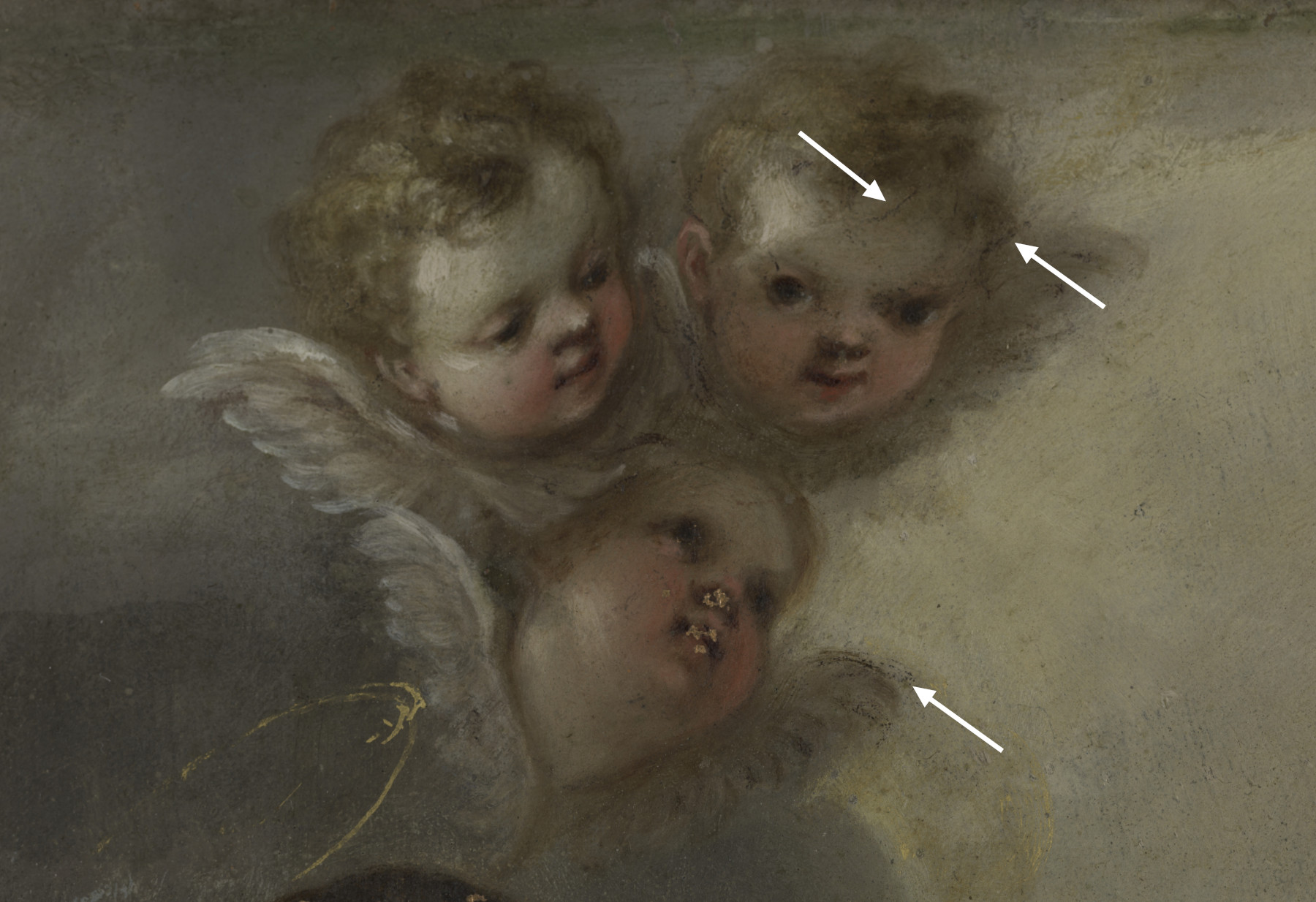 Fig. 5
Fig. 5The initial stages of the composition were laid in using a dilute layer of brownish paint. This painted underdrawing is particularly noticeable through the superficial abrasions present within the group of cherubs in the upper left corner (Fig. 5). IRR further revealed a loose sketch that appears to have been made using a split-nib quill pen, concentrated in the lower right quadrant, which was applied after the painted underdrawing. Aguilera used a pen with a fluid, carbon-based black medium, most likely a form of ink, to outline the prominent jawline of a male figure along the right-hand edge, suggesting a full beard.30 Ultimately, the painter decided to cover the jaw of the man with his arms stretched toward the Virgin and added a tonsure on his head to represent a monk (Fig. 6). This revision, which effectively morphed the figure from a layman to a clergyman, no doubt also presented significant iconographic changes, in the sense that it offered a broader moral commentary relating to the collection of souls, as even the clergy was not spared from damnation. In addition to the outline of the chin in pen, a diagonal line below the head was made using the same drawing utensil and medium to act as a placeholder for the figure’s left shoulder. Aguilera also used a dry, carbon-based black medium to delineate the right bent leg of another male soul praying in the lower right corner. In the final stages of painting, this leg was completely covered by the flaming lake. Aguilera’s effective use of both fluid and dry media for a localized underdrawing demonstrates his creative process in constructing this complex arrangement of figures. It is noteworthy that, to date, there is little evidence indicating that New Spanish painters used carbon-based black media for their underdrawings.31 It is possible that the painting’s metallic support and light-colored ground may have made it more feasible to use a split nib and ink for the quickly sketched underdrawing. In any case, until more underdrawings are revealed through the technical study of New Spanish paintings, this example remains an anomaly among paintings from this region.
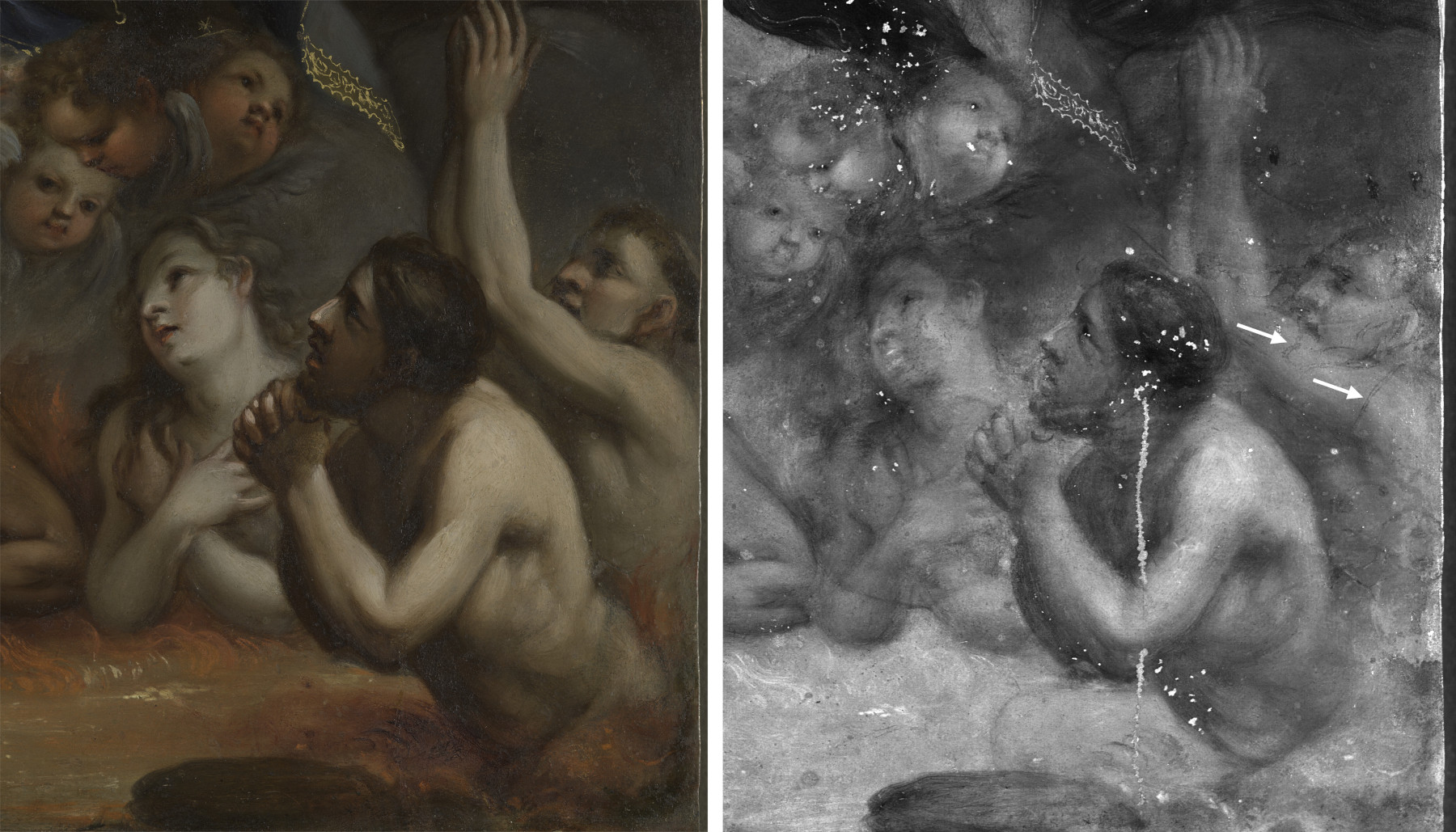 Fig. 6
Fig. 6Painting Technique
The Virgin of Carmen has a luminous quality, imparted by the smoothness of the support and the brightness of the ground, which serve to unify the composition. The thinness and relatively simple structure of the paint buildup demonstrate Aguilera’s sophisticated and economical technique, utilizing the color of the ground when necessary. Aguilera created atmospheric effects in the sky and the clouds bolstering the saints with crisscrossed brushstrokes that blend light blue, pink, yellow, and gray passages of oil paint. These pastel transitions served to split the composition into two horizontal sections, dividing heaven and purgatory. The figures, especially the saints, were held in reserve. The grayish ground can be seen through the contours around the shoulders and head of the Virgin and the Prophet Elijah. Aguilera’s skill in describing texture is evident in the Virgin’s hair, where he applied an under-bound earth pigment with a stiff brush to create airy curls. In contrast, to paint the pelt on the prophet’s shoulder, he stippled bodied lead white, which he then agitated with a flick of the wrist to give the impression of fur (Fig. 7).
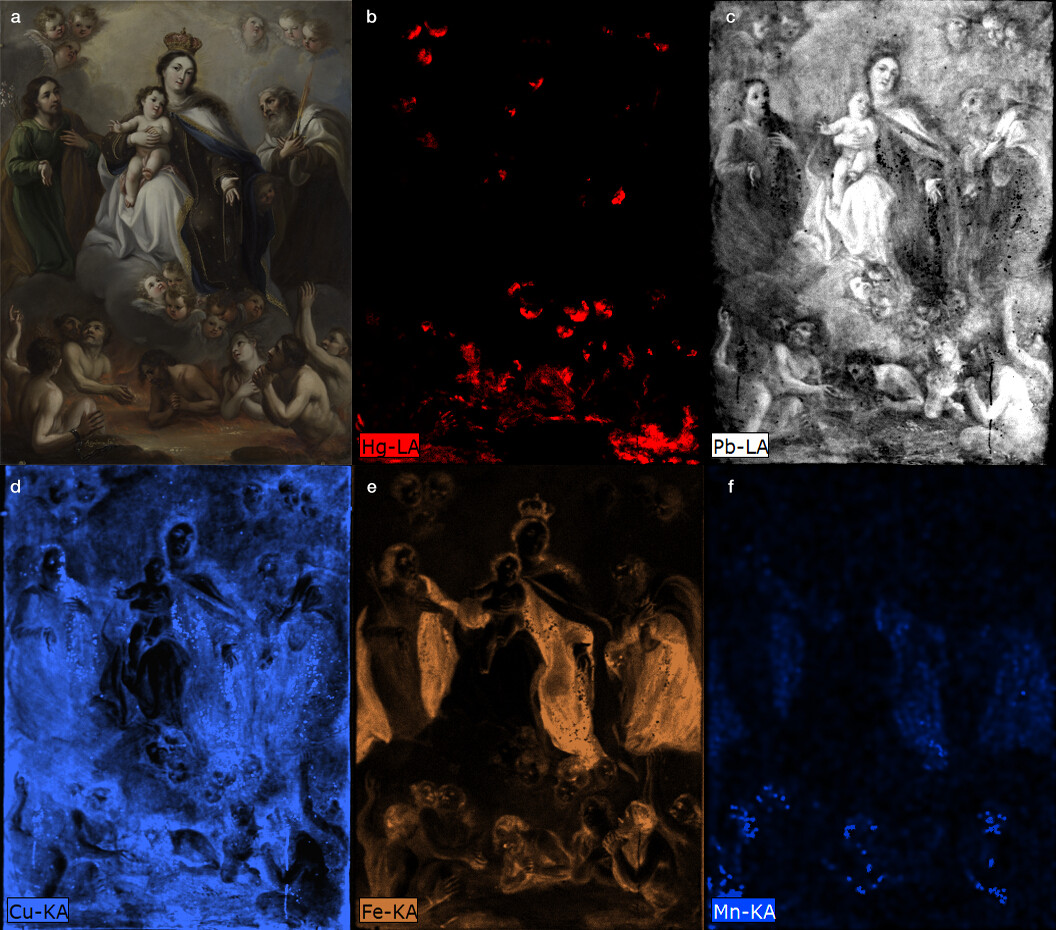 Fig. 8
Fig. 8Due to the generally good condition of the paint layers, physical sampling was limited and MA-XRF was used to determine the distribution of pigments, which included vermilion, lead white, a copper-based pigment (possibly verdigris), and iron-based earths, including ocher and umber—all commonly available at the beginning of the eighteenth century (Fig. 8). For the flesh tones, Aguilera used a direct method, expressive yet systematic in approach, with virtually no blending. For example, in the detail of the only woman in purgatory, over the initial brown underpaint the artist applied a brown glaze in her brow and temple (Fig. 9). He then built up the structure of the face with pink paint on the ear, under the nose, and on the cheeks followed by pale highlights of a thicker consistency. The corner of the mouth was painted with tiny strokes using a deep red, most likely a red lake, while the lips were simply suggested with two parallel strokes of vermilion. The profile of the praying man visible in figure 9 was modeled in a similar manner. However, here the artist applied a dab of white paint over the ground for the highlight of the nose, which he then guided along the length of the nose with a brush loaded with pink paint. The same technique was used in the highlight of the black shackles, where dabs of blue and white paint were dragged with a dry brush or stick, resulting in fine, unmixed skeins of paint (Fig. 10). To redefine the figures and distinguish details such as the fingers and eyes, the artist applied fluid brown paint with a fine brush to outline shadows over the finished painting.
The blue lining of the Virgin’s mantle and Saint Joseph’s green robe feature distinct areas of color. The blue pigment, which is remarkably well preserved, was identified as indigo.32 This organic pigment has also been reported in other New Spanish paintings.33 American indigo from the Audiencia of Guatemala*, indigofera suffruticosa*, was considered among the finest indigo during the eighteenth century, and it is possibly the one Aguilera used to paint the lining.34 In this area, the shadows were made primarily with thick layers of indigo while lead white was added in the highlights. Joseph’s robe received a similar treatment. It was painted with a copper-containing pigment, possibly verdigris, with highlights composed of lead white mixed in with an unidentified yellow pigment.
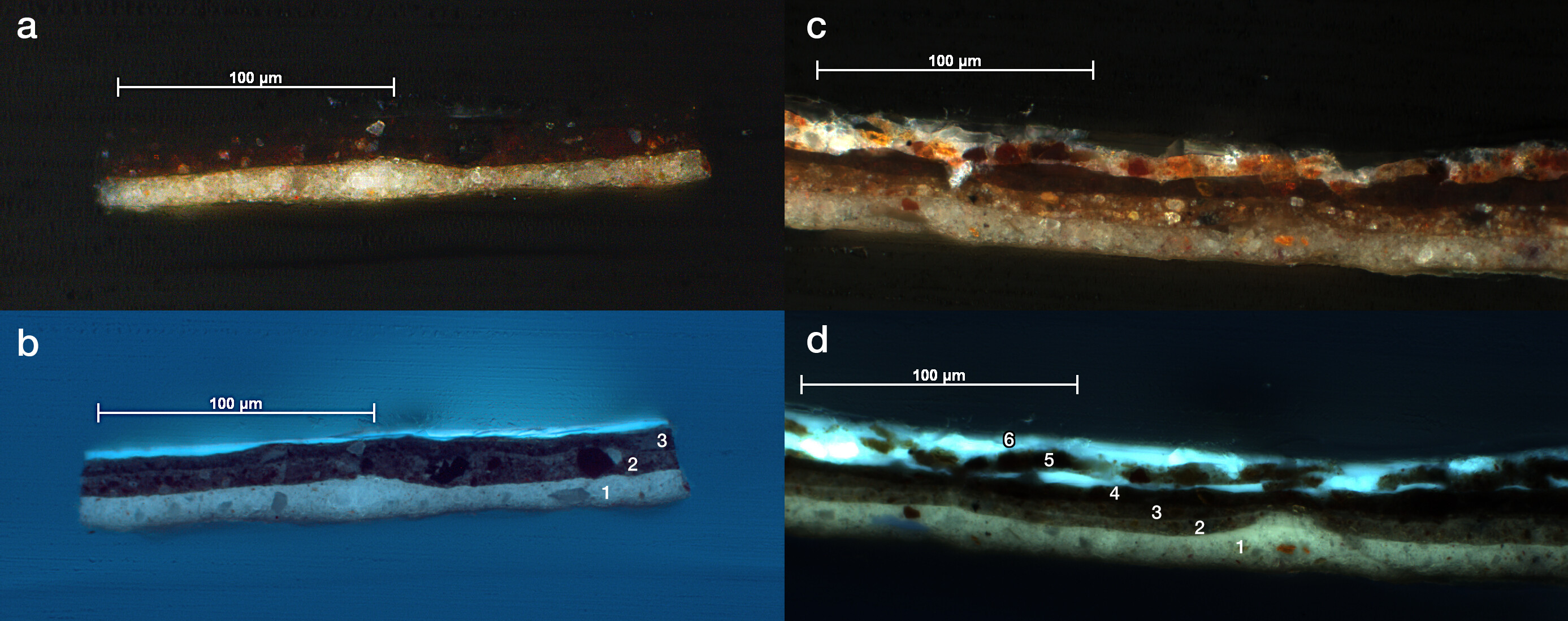 Fig. 11
Fig. 11The Virgin of Carmen has minute paint and ground losses localized in areas of dark brown paint. Flaking of dark colored areas is the most common form of degradation observed in paintings on copper supports, likely due to the mechanical behavior of oil-bound earth layers.35 To investigate this condition, two samples (S1 and S2; Figs. 8a, 11) were taken from the brown robe of the Virgin and the shadow on Saint Joseph’s yellow cloak. Sample S1 revealed two paint layers over the ground preparation [1], the lower one containing a carbon-based black pigment and an ocher (layer [2]; Fig. 11b), while the upper one was composed of a mixture of a carbon-based black and red lead (layer [3]; Fig. 11b). Sample S2 showed four paint layers over the ground [1]. The first two are similar in composition, containing orpiment and a carbon-based black; the lower layer (layer [2]; Fig. 11d) is lighter than the subsequent one (layer [3]; Fig. 11d), showing Aguilera’s additive modeling of the fabric. Over these two layers, the artist painted a dark brown shadow containing red ocher and a carbon-based black (layer [4]; Fig. 11d). Finally, this area was topped with a scumble containing coarsely ground ocher (layer [5]; Fig. 11d), which appears to be imbibed in a natural resin varnish [6] that seeped under this layer when it was applied in a previous restoration. In addition to the pigments identified in the cross-sections, MA-XRF gave signals for iron and manganese for all brown colors, suggesting the presence of an umber (Figs. 8e, 8f). The localized flaking suggests that failure of adhesion is due to the pigments used, likely earth-based and carbon-based black. However, more complex chemical interactions may also account for this.
Reflective elements, such as the halos, trim of the mantle, and crown of the Virgin, were executed with subtle brushstrokes in shell gold. Aguilera used a smaller brush for this last stage, controlling the thickness of the line to generate particular effects.36 For example, the flaming sword of the Prophet Elijah was painted with a few thick tapering brushstrokes over a vermilion paint layer to depict fire, while the halo of the Virgin was made with a series of fine undulating marks that trail off, creating an ethereal effect toward the outer rim (Fig. 7). Aguilera’s self-confidence as an artist may be surmised from his use of gold to sign his own name. These gold highlights are not merely decorative. In The Virgin of Carmen, the reflective vibrations of the gold would have been animated by candlelight, no doubt enhancing the function of the painting as an object of devotion by lending it an aura of the sublime. An affinity for the religious symbolism of reflective surfaces is noted in two unique art forms that emerged in New Spain: enconchados, paintings on wooden panels inlayed with mother-of-pearl; and arte plumario, featherwork paintings in which iridescent feathers were often adhered to paper with tzhautli, the mucilage of orchid bulbs, and laid on copper. 37 The inspiration for these artworks came from Japanese and indigenous knowledge, respectively, and their appropriation was likely induced by their dynamic light effects, which were linked with the divine in widely circulated devotional images in the Catholic world.38
The Frame
The painting arrived at The Metropolitan in a cabinetmaker’s frame with ebonized fruitwood molding, tortoiseshell veneer, and cast-silver ornaments. The precious materials used in the construction of the frame point to a wealthy patron. Inventories show that devotional paintings on copper were not costly per se. Rather, it is the value of their accompanying frames that is reflected through their documented high prices.39 The presence of The Virgin of Carmen in Spain by the 1850s suggests it could have been brought from Mexico in the tornaviaje, the trip back home that Spaniards took after serving as merchants or colonial officials in New Spain.40
The painting fits almost perfectly within the thin rebate of the frame, which in turn suggests that the frame was made to accommodate the dimensions of the copper support. Structurally, the architrave frame is similar to those made in Antwerp for export to Spanish and Spanish American markets from the second quarter of the seventeenth century onward.41 Nevertheless, a New Spanish manufacture cannot be ruled out. Although the construction of the frame follows a European tradition, the raw materials used to create it may be American in origin. Tortoiseshell-inlay techniques had been a long-standing tradition in the Bay of Campeche, Mexico, where craftsmen exploited the translucent colors of this protein-rich material.42 To create an opulent scheme and to prevent the wood and glue from being seen through the veneer, woodworkers would often line the back with red paper.43 Point XRF analysis detected mercury in an area where the red rag paper was exposed, indicating the presence of vermilion. The same analytical technique showed the presence of gold on the silver seraphs nailed to the frame, with larger amounts found in the crevices. No mercury was detected in combination with gold, possibly ruling out a fire-gilding technique. The gold may have been applied using other gilding methods, perhaps a displacement-plating process, although this can only be confirmed with further analysis. Evidently, the gold was removed intentionally at some point, possibly because the thin layer of metal suffered damage or abrasion with use. To picture the ensemble’s appearance when the seraphs were gilded, a digital simulation was created (Fig. 12). In the simulation, the overall warm scheme of the frame balances the fine shell-gold elements of the composition.
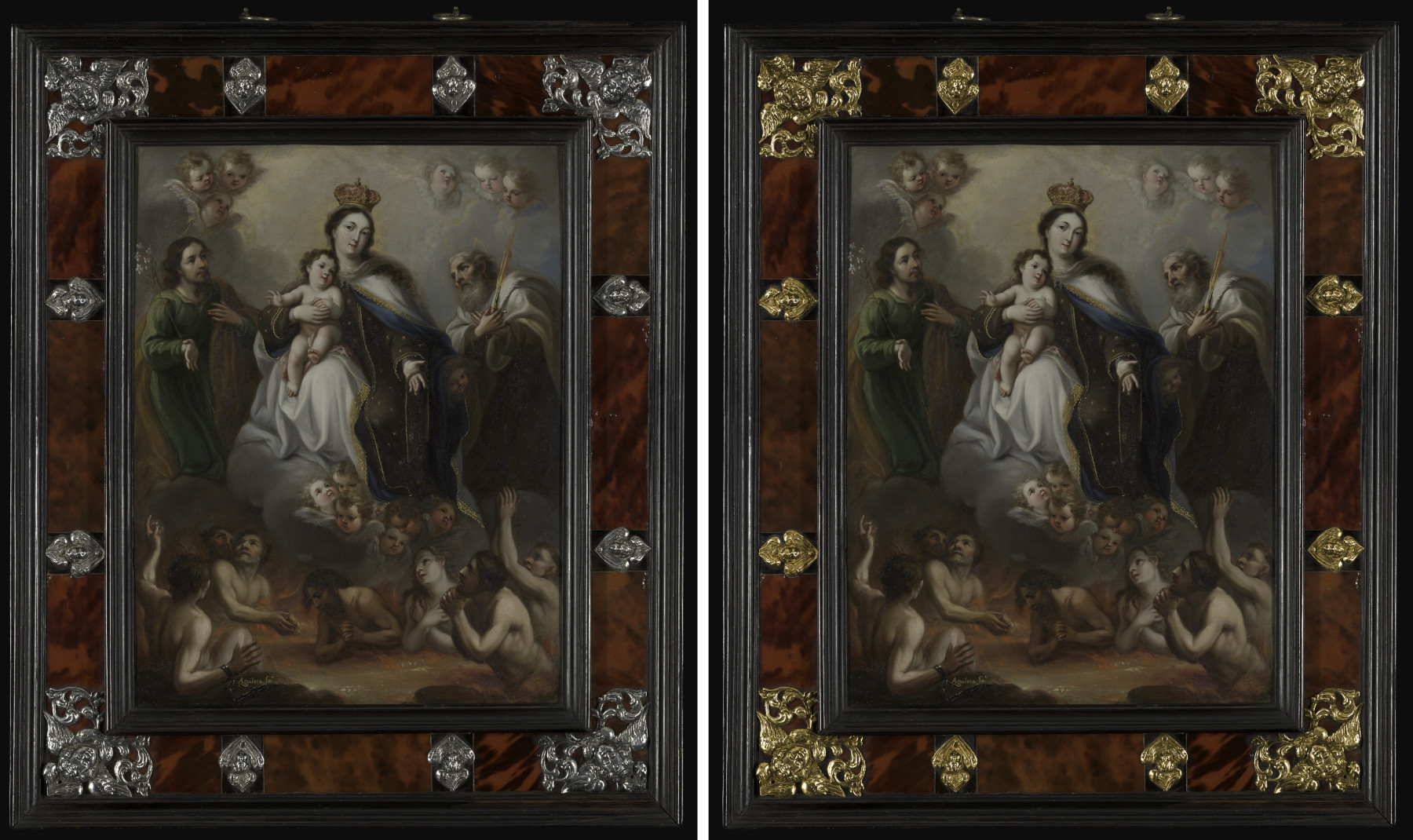 Fig. 12
Fig. 12Conclusion
Despite the apparent recognition that Aguilera received in his lifetime, and the recent acquisition of his works by North American museums, very little is known about him or his technique. Lacking period documentation, only physical evidence locked within Aguilera’s works can provide insight into his materials, his methods, and aspects of his artistic process. This study has elucidated Aguilera’s creative process in The Virgin of Carmen, in which the careful preparation of the ground, important changes to the composition, and sophisticated paint handling points to a mature artist confident in his skills. His approach, established in three schematic zones of space, is economically effective and serves as proof of a trained hand. The gestural and shorthand quality of his painted underdrawing reveals an artist comfortable with complex anatomical subjects, in which precise guidelines were not necessary to execute a highly detailed image. The local split-nib pen-and-ink sketch indicates that Aguilera developed The Virgin of Carmen as he painted it. This is supported by his choice not to follow his sketch of the figure, which in turn changed the iconography and consequent moral message of the painting. Only the study of additional infrared reflectograms of Aguilera’s paintings will determine if quick notations or sketches in pen and ink, like the one shown here, were common practice for the artist and others in his circle.
The unprecedented comment in the Spanish translation of Francesco Lana’s treatise noting Aguilera’s direct paint application suggests that the painter shared his technical knowledge with his peers. This apparent collegiality may have earned him the citation along with two of the foremost painters in the early eighteenth century. To paint The Virgin of Carmen, Aguilera began with a subtle and controlled approach in the background, blending the surface to the point where brushstrokes became imperceptible, while in the figures, details were created with abstracted strokes of paint that were not overworked. In addition to mixing pigments on his palette and the support with a brush, Aguilera manipulated dabs of oil paint to create skeins of unmixed paint in the iron shackles above the signature, possibly using a stick or the end of a brush. The dichotomy between a controlled and an energetic paint handling exemplifies the bold gestures seen throughout this masterfully accomplished painting and brings us closer to understanding Aguilera’s celebrated technique.
Methods
Infrared reflectography (IRR)
IRR was done using an OSIRIS InGaAs near-infrared camera with a 6-element, 150 mm focal length, f/5.6–f/45 lens, and 900–1700 nm spectral response. A single capture was made at 33.8 and 15 in. and 4096 × 4096 pixels.
Macro‑X‑ray fluorescence (MA‑XRF) mapping
MA-XRF mapping was carried out using a Bruker M6 Jetstream instrument equipped with a 30 mm² XFlash® silicon drift detector (SDD) and an air-cooled micro-focus Rh-target X-ray tube operated at 50 kV and 0.5 mA. The full painting was mapped with a 700 μm spot size, a 700 μm step size, and a dwell time of 80 ms/pixel. The spectra were processed using the Bruker M6 Jetstream software.
Point XRF
Point XRF was carried out with a Bruker Artax 400®, equipped with a 10 mm^2^ XFlash® silicon drift detector (SDD), and a rhodium X-ray tube operating at 50 kV and 700 µA. Spectra were acquired for 60 seconds using a 1 mm pinhole collimator and no primary beam filters.
Samples and Optical Microscopy
Samples were taken using a scalpel under magnification, mounted as cross-sections in Technovit® resin, and polished using Micromesh® cloth. For the microscopic examination, a Zeiss Axio Imager M2m microscope, with 50×, 100×, 200×, 400×, and 500× magnifications, an Axiocam HRc digital camera, and AxioVision 4.X.X software were used.
Raman spectroscopy
Raman spectroscopy measurements were done in situ in the painting and in the sample cross-sections using a Renishaw System 1000 coupled to a Leica DM LM microscope. All the spectra were acquired using a 785 nm laser excitation, a 1200 lines/mm grating, and integration times between 10 and 120 s. The power at the sample was set between 0.5 and 5 mW using neutral density filters. When working in situ, a log working distance 20× objective lens was used while a 50× lens was employed to analyze the paint cross-sections.
Acknowledgments
The authors thank Michael Gallagher, Sherman Fairchild Chairman, Paintings Conservation, and Ronda Kasl, curator of Colonial Latin American Art, for their support, interest, and fruitful contributions to this discussion. The authors are also indebted to Charlotte Hale, paintings conservator, for providing valuable suggestions; and to Evan Read, manager of technical documentation, for preparing the digital simulation of the frame. Thanks to the Museo Nacional de Arte, Instituto Nacional de Bellas Artes and the Museo Soumaya, both in Mexico City, for allowing us to illustrate paintings from their collections in this publication.
Authors’ Bios
José L. Lazarte is an Assistant Conservator of Paintings in the Department of Paintings Conservation at The Metropolitan Museum of Art. Lazarte joined The Met in 2016 where he held the positions of Mellon Fellow in Paintings Conservation and Research Scholar prior to his current title. He works primarily with European paintings of the 16th to the 18th centuries and American paintings, including works from colonial Latin America. José received a B.A. in Art Conservation with a Minor in Studio Arts from the University of Delaware, and an M.Sc. from the Winterthur/University of Delaware Graduate Program in Art Conservation in 2016. During his studies, he undertook internships at the Yale University Art Gallery, the Prado Museum and the Fine Arts Museums of San Francisco. Email: joseluis.lazarteluna@metmuseum.org.
Silvia A. Centeno is a Research Scientist in the Department of Scientific Research at The Metropolitan Museum of Art. Centeno focuses on artists’ materials and techniques and deterioration processes in paintings, photographs, and works of art on paper. She received a PhD in chemistry from Universidad Nacional de La Plata, Argentina, and started at The Met as an L. W. Frohlich Fellow to study unusual gilding techniques in Pre-Columbian metalwork. She has published and lectured on a number of topics, including pigment- and platinum-based photographic processes, daguerreotypes, heavy-metal soap deterioration in oil paintings, modern paints, early lithographic inks, and Renaissance paintings. As a Research Scientist, whe currently leads interdisciplinary team projects working on the elucidation of nineteenth-century photographic processes and on the deterioration of oil paintings. Email: silvia.centeno@metmuseum.org.
Federico Carò is a Research Scientist in the Department of Scientific Research at The Metropolitan Museum of Art. Carò received his PhD in earth science from the University of Pavia, Italy, where he worked on the characterization of natural and artificial building materials. As a Research Scientist at The Met, he investigates inorganic materials and techniques employed in artistic production, in close collaboration with conservators and curators. Particularly, his research interests focus on the mineralogical, petrographic, and geochemical characterization of stone and other geological materials in provenance and conservation studies. Since 2007, he has been involved in the study of Southeast Asian sculptural and architectural stone materials. Email: federico.caro@metmuseum.org.
Notes
Ilona Katzew, “Valiant Styles: New Spanish Painting, 1700–85,” in Painting in Latin America, 1550–1820, ed. Luisa Elena Alcalá and Jonathan Brown (New Haven: Yale University Press, 2014), 153. ↩︎
For transcripts of this document, see Guillermo Tovar de Teresa, Bibliografía novohispana de arte: Segunda parte; Impresos mexicanos relativos al arte del siglo XVIII (Mexico City: Fondo de Cultura Económica, 1988), 104–5; and Paula Mues Orts, La libertad del pincel: Los discursos sobre la nobleza de la pintura en Nueva España (Mexico City: Universidad Iberoamericana, , 2008), 397–98. ↩︎
Mues Orts, La libertad del pincel, 260–67. ↩︎
Luisa Elena Alcala et al., “Painted in Mexico, 1700–1790: Pinxit Mexici,” in Painted in Mexico, 1700–1790: Pinxit Mexici, ed. Ilona Katzew (Los Angeles: Los Angeles County Museum of Art; Mexico City: Fomento Cultural Banamex; Munich: DelMonico Books/Prestel, 2017), 16–49. ↩︎
Mues Orts, La libertad del pincel, 262. ↩︎
Myrna Soto, El arte maestra: Un tratado de pintura novohispano (Mexico City: Universidad Nacional Autónoma de México, 2005), 58–59; Mues Orts, La libertad del pincel, 262. ↩︎
A baptismal certificate dated May 25, 1680, was located by JoAnna Reyes Walton and Kinga Novak, research scholars at the Los Angeles County Museum of Art, and published in Katzew, Painted in Mexico, 182. Published here for the first time, a baptismal certificate was found for a Juan Francisco de Aguilera in the book of baptized españoles (Mexicans of Spanish descent) in the Cathedral of Mexico City: “Bautismo de Juan Francisco de Aguilera, April 15, 1671.” Bautismos de Españoles, 1663–1674, libro 23, p. 123, Registros Parroquiales y Diocesanos, 1514–1970, Asunción Sagrario Metropolitano, Mexico City. ↩︎
The Mexican painter José de Ibarra has been proposed as one of the translators for Lana’s El arte maestra. Paula Mues Orts, “El arte maestra: Traducción novohispana de un tratado pictórico italiano, parte 1,” Estudios en torno al arte, no. 1 (2006): 17, 78, 82. ↩︎
Authors’ translation from Mues Orts, “El arte maestra,” 102. ↩︎
Jonathan Brown, “From Spanish Painting to New Spanish Painting, 1550–1700,” in Alcalá and Brown, Painting in Latin America, 118; and Mues Orts, La libertad del pincel, 262. ↩︎
Rogelio Ruiz Gomar, “Juan Francisco de Aguilera: La Purísima Concepción con Jesuitas,” in Catálogo comentado del acervo del Museo Nacional de Arte, ed. Gomar, Nelly Sigaut, and Jaime Cuadriello (Mexico City: Universidad Nacional Autónoma de México, Instituto de Investigaciones Estéticas, 2004), 2:60; Ilona Katzew, “Valiant Styles,” 159. ↩︎
Paula Mues Orts, “Illustrious Paintings and Modern Brushes,” in Katzew et al., Painted in Mexico, 52–75. ↩︎
Saint Thomas Aquinas, Catechism of the Summa Theologica 1485, ed. R. P. Thomas Pègues and Aelred Whitacre (New York: Benzinger, 1922), 295. ↩︎
Marcela Rocío García Hernández, “Los Carmelitas y el purgatorio, 1600–1750,” in Muerte y vida en el más allá: España y América, siglos XVI–XVIII, ed. Gisela von Wobeser and Enriqueta Vila Vilar (Mexico City: Universidad Nacional Autónoma de México, Instituto de Investigaciones Estéticas, 2009) 259–82. ↩︎
The support measures 32.2 by 24.5 cm, with a thickness ranging from 1.1 to 0.9 mm throughout. ↩︎
Elemental composition of the copper support was identified by point X-ray fluorescence spectroscopy. ↩︎
Isabel Horovitz, “Paintings on Copper: A Brief Overview of Their Conception, Creation and Conservation,” in Paintings on Copper and Other Metal Plates: Production, Degradation, and Conservation Issues = La pintura sobre cobre y otras planchas metálicas: Producción, degradación y conservación, ed. Laura Fuster López et al. (Valencia: ComunicaCC, 2017) 17–26; David A. Scott, “Copper Compounds in Metals and Colorants: Oxides and Hydroxides,” Studies in Conservation 42, no. 2 (1997): 93–100. ↩︎
Clara Bargellini, “Painting on Copper in Spanish America,” in Copper as Canvas: Two Centuries of Masterpiece Paintings on Copper, 1575–1775 (New York: Oxford University Press, 1999) 31–44. ↩︎
Elinore M. Barret, The Mexican Colonial Copper Industry (Albuquerque: University of New Mexico Press, 1987). ↩︎
Sandra van Gihoven, “Flemish Dealers and a Thriving Transatlantic Art Trade During the 17th Century,” in Trading Painters and Painters’ Materials, 1550–1800, ed. Anne Haack Christensen and Angela Jager (London: Archetype; Copenhagen: CATS, 2019) 15–25, 21; Bargellini, “Painting on Copper,” 35; Neil de Marchi and Hans J. van Miegroet, “Exploring Markets for Netherlandish Paintings in Spain and Nueva España,” in Nederlands Kunsthistorisch Jaarboek (NKJ)/Netherlands Yearbook for History of Art 50 (Leiden: Brill, 1999): 80–111. ↩︎
Isabel Horovitz, “The Materials and Techniques of European Paintings on Copper Supports,” in Copper as Canvas, 63–92. ↩︎
Horovitz, “Materials and Techniques,” 65. ↩︎
José María Lorenzo Macías, “El arquitecto ensamblador Mateo de Pinos,” Anales del Instituto de Investigaciones Estéticas 86 (2005): 113–67; Cristina Ratto, “Entre pinceles y cuadros: Los libros del pintor Miguel Cabrera,” Revista complutense de historia de América 45 (2019): 89–112. ↩︎
For an example of a New Spanish variation on ash-containing preparations mentioned in the art treatises of Francisco Pacheco (1564–ca. 1644) and Antonio Palomino (1655–1726), see Silvia A. Centeno et al., “New Light on the Use of Ash in the Ground Preparations of Baroque Paintings from Spain, North and South America,” in Mobility Creates Masters: Discovering Artists’ Grounds, 1550–1700 (London: Archetype, 2020) 21–30. ↩︎
Bonaventura Bassegoda i Hugas, Arte de la pintura: Francisco Pacheco (1564–1644) (Madrid: Cátedra, 1990), 482. ↩︎
Lydia-Chara Pavlopoulou and David Watkinson, “The Degradation of Oil Painted Copper Surfaces,” Reviews in Conservation 7 (2006) 55–65. ↩︎
Lydia-Chara Pavlopoulou, “Chemical, Physical and Mechanical Decay Procedures in Oil Painted Copper Objects,” in Paintings on Copper and Other Metal Plates, 83–94. ↩︎
Lead white oil-grounds tinted with pigments are recommended for painting on copper by several historic treatises throughout the seventeenth and eighteenth centuries; see Maartje Stols-Witlox, A Perfect Ground: Preparatory Layers for Oil Paintings, 1550–1900 (London: Archetype, 2017), 63. ↩︎
Antonio Palomino de Castro y Velasco, El museo pictórico, y escala optica, tomo segundo (Madrid: Imprenta de Sancha, 1797), 50. ↩︎
The use of a split-nib pen is indicated by the parallel ridges of fluid black medium left when the tip of the pen was pressed and dragged on the surface of the priming. ↩︎
Mues Orts, “Illustrious Paintings and Modern Brushes,” 58. ↩︎
This pigment was identified non-invasively by in situ Raman spectroscopy. ↩︎
Mirta Asunción Insaurralde Caballero, La pintura a inicio del siglo XVIII novohispano: Estudio formal, tecnológico y documental de un grupo de obras y artífices; Los Arellanos (Phd diss., Universidad Nacional Autónoma de México, 2018), 260–64; Elsa Arroyo et al., “Variaciones celestes para pintar el manto de la Virgen,” Anales del Instituto de Investigaciones Estéticas 34 (2012): 85–117, 99; Tatiana Falcón and Javier Vázquez, “José Juárez: La técnica del pintor,” in José Juárez: Recursos y discursos del arte de pintar (Mexico City: Museo Nacional de Arte/Banamex, 2002) 283–310. ↩︎
Francisco Zamora Rodrígues, “Central American Indigo, Globalization and Socioeconomic Effects, 16th–17th Centuries,” Análise social 52, no. 224 (2017): 584–607. ↩︎
Marion F. Mecklenburg, Charles Tumosa, and David Erhardt, “The Changing Mechanical Properties of Aging Oil Paints,” in Materials Research Society Proceedings 852, ed. Pamela B. Vandiver, J. L. Mass, and A. Murray, Materials Issues in Art and Archaeology 7 (2005): 13–24; Laura Fuster–Lopez et al. “Study of the Chemical Composition and the Mechanical Behaviour of 20th Century Commercial Artists’ Oil Paints Containing Manganese-based Pigments,” Microchemical Journal 124 (2016): 962–73. ↩︎
The binding medium of the shell gold was not analyzed. ↩︎
Sonia Ocaña, “Enconchados: Gustos, estrategias y precios en Nueva España,” Anales del Instituto de Investigaciones Estéticas 37, no. 106 (2015): 75–112; Mercedes Amézaga, “Restauración del cuadro-mosaico de plumas sobre cobre y papel: La Inmaculada Concepción, Museo de América,” AKOBE: Restauración y conservación de bienes culturales = Ondasunen artapen eta berriztapena 9 (2011): 65– 69. ↩︎
Sonia Ocaña, “Enconchados: Japanese Appropriations, Arnamentation and Light Symbolism in New Spain,” Caiana 10 (2017): 1–17; Luisa Elena Alcala, “Reinventing the Devotional Image: Seventeenth-Century Feather Paintings,” in Images Take Flight: Feather Art in Mexico and Europe, ed. Alessandra Russo, Gerhard Wolf, and Diane Fane (Munich: Hirmer, 2016), 387–405. ↩︎
Clara Bargellini, “La pintura sobre lámina de cobre en los virreinatos de la Nueva España y del Perú,” Anales del Instituto de Investigaciones Estéticas 21, no. 75 (1999): 79–98. ↩︎
In 1785 the Spanish-born merchant Juan Bautista de Echeverría y Latadi (1744–1816) commissioned five devotional paintings from the Mexican painter Nicolás Enríquez (1704–ca. 1773) for his return back to Spain; see Ronda Kasl, “Nicolas Enriquez,” in Katzew et al., Painted in Mexico, 475–476. For an exhaustive analysis of tornaviaje trousseaux, see Andrés Guitiérrez Usillos, “El recuerdo de América en España: El ajuar de D.a María Luisa y de otras damas nobles a finales del siglo XVII,” in La hija del Virrey: El mundo femenino novohispano en el siglo XVII, ed. Andrés Gutiérrez Usillos and Rocío Bruquetas Galán (Madrid: Ministerio de Cultura y Deporte, 2019), 85–219. ↩︎
Paul Mitchell and Lynn Roberts, A History of European Picture Frames (London: Merrell Holberton, 1996), 81; Sandra van Gihoven, “Flemish Dealers,” 19. ↩︎
Jack Frazier and Reiko Ishihara-Brito, “The Occurrence of Tortoiseshell on a Pre-Hispanic Maya Mosaic Mask,” Antiquity 86 (2012): 825–37. ↩︎
Marloes Rijkelijkhuizen, “Tortoiseshell in the 17th and 18th Century Dutch Republic,” in Ancient and Modern Bone Artefacts from America to Russia: Cultural, Technological and Functional Signature, ed. Alexandra Legrand-Pineau et al. (Oxford: Archaeopress, 2010), 98. ↩︎
